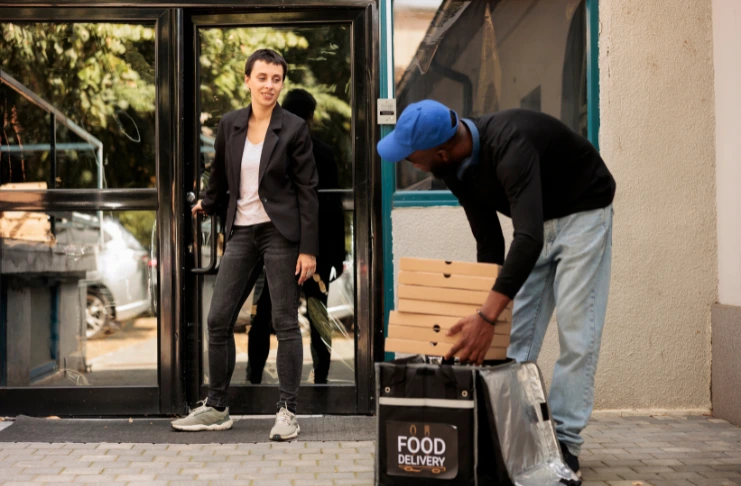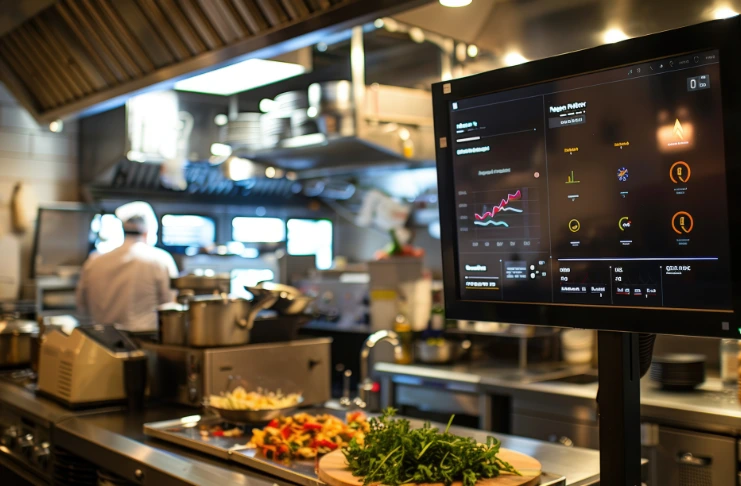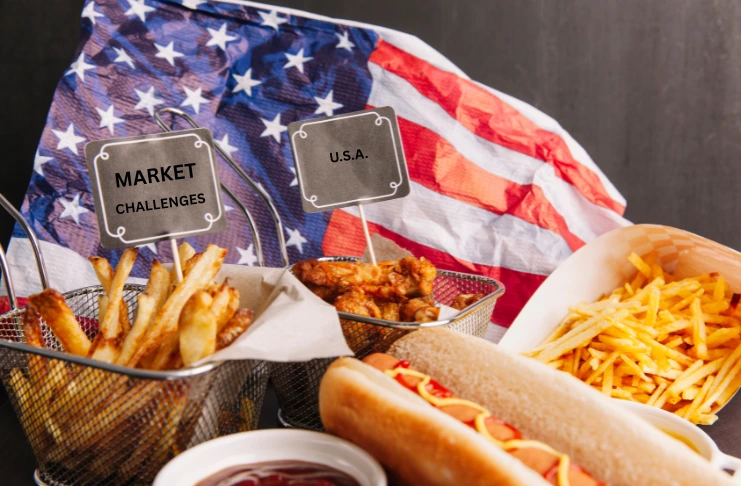The rise of online food delivery, combined with a shift in dining behavior post-pandemic, has fueled massive growth in the cloud kitchen or ghost kitchen model across the United States. These delivery-focused operations have transformed how restaurants approach the market, offering lower overhead and greater flexibility.
The global cloud kitchen market size was estimated at 58.61 billion U.S. dollars in 2022 and is forecast to reach 177.85 billion U.S. dollars by 2032. This remarkable growth trajectory highlights the fundamental shift in consumer preferences and cloud kitchen business models within the food service industry.
With platforms like Uber Eats, DoorDash, and Grubhub dominating food delivery, cloud kitchens offer a streamlined, cost-efficient, and scalable solution to enter or expand in the food business. These tech-enabled kitchens leverage data analytics and digital marketing to optimize menu offerings and reach target customers without the traditional barriers to entry.
This blog covers how to run a successful cloud kitchen business, including success tips, management strategies, profitable business models, and insider best practices for thriving in a highly competitive market. Whether you’re an entrepreneur looking to launch your first food venture or an established restaurateur seeking to diversify revenue streams, cloud kitchens present compelling opportunities worth exploring.
What Is a Cloud Kitchen?

A cloud kitchen restaurant is a delivery-only restaurant. Unlike traditional eateries, it doesn’t offer dine-in services — it exists to fulfill online orders from third-party platforms or direct-to-consumer channels. This focused approach eliminates the need for expensive storefront locations and front-of-house staff.
Also known as virtual kitchens, dark kitchens, or ghost kitchens, this model cuts down real estate and front-of-house costs while focusing on fast, tech-enabled delivery operations. Cloud kitchens can operate from industrial areas, basements, or other lower-cost locations that would be unsuitable for traditional restaurants, further reducing overhead expenses.
The streamlined business model allows operators to focus exclusively on food quality and operational efficiency. With no physical customers to accommodate, these kitchens can be designed purely for production speed and workflow optimization, increasing output capacity while maintaining consistent quality standards.
Why Cloud Kitchens Are Gaining Momentum in the U.S.

Choosing the right cloud kitchen model is key to aligning your business with your goals and budget. From single-brand setups to shared spaces, here are the most viable models that cater to different scales and strategies in the U.S. market.
1. Cost Efficiency
Without dining areas or extensive FOH staff, operational costs drop significantly — often by 30% to 50% compared to traditional restaurants. This is primarily due to the elimination of expenses associated with maintaining a dining area and employing front-of-house staff. For instance, cloud kitchens can operate from non-prime locations, saving on rental expenses, and require fewer staff members, leading to lower labor costs.
2. Surge in Delivery Culture
According to Deliverect, the U.S. online food delivery market is expected to generate $429.90 billion in 2025. This substantial growth underscores the increasing consumer demand for convenience, positioning cloud kitchens to effectively meet this need.
3. Faster Launch & Scalability
Operators can launch multiple brands from the same kitchen and expand to new locations without leasing expensive storefronts.
Cloud Kitchen Business Models to Explore

Cloud kitchens can be run in several ways depending on your goals, budget, and operational capacity. Below are the most common and successful models in the U.S. that entrepreneurs use to enter and scale in the delivery-first food industry.
1. Single-Brand, Single-Kitchen Model
This model focuses on a single food concept, operating out of one centralized kitchen location. It’s perfect for first-time entrepreneurs or chefs who want to test a niche menu without high overhead. Since resources aren’t split between multiple brands, quality and operations can be fine-tuned more easily. It also allows for gradual scaling once the concept proves successful.
2. Multi-Brand Cloud Kitchens
In this model, you run several virtual restaurant brands under one roof, each with its own identity, menu, and target audience. For example, you can operate a burger brand, a vegan bowl brand, and a dessert brand simultaneously. It maximizes kitchen resources and boosts order volumes across different food categories. Data from delivery apps can help tailor each brand for hyperlocal success.
3. Kitchen-as-a-Service (KaaS)
This plug-and-play model lets entrepreneurs rent fully equipped commercial kitchen spaces from providers like CloudKitchens, Kitchen United, or REEF Technology. You don’t have to invest heavily in infrastructure; just bring your team and ingredients. It’s ideal for rapid market entry or testing new locations. Most KaaS providers also offer logistics, tech, and marketing support.
4. Hybrid Models
Hybrid kitchens offer both delivery and takeout, sometimes with limited dine-in or walk-up counter service. This model works well in urban locations or areas with high foot traffic where customers might prefer to grab their food in person. It blends the efficiency of a cloud kitchen with some benefits of a traditional storefront. These setups can also boost brand visibility locally.
Setting Up a Cloud Kitchen in the U.S.: Step-by-Step Guide

Launching a cloud kitchen involves more than just cooking good food — it requires strategy, permits, and tech infrastructure. Here’s a detailed roadmap to help you build your cloud kitchen from concept to operations.
1. Conduct Market Research
Start by identifying customer demand, trending cuisines, and competitor gaps in your target delivery zone. Use tools like Google Trends, DoorDash Consumer Insights, and Yelp to analyze what’s selling locally. Study demographics and popular dietary habits in your city or region. Research helps you validate your menu, pricing, and brand identity before launch.
2. Choose the Right Location
Cloud kitchens don’t need prime real estate, but proximity to densely populated areas is crucial for faster delivery and lower costs. Look for affordable industrial zones or commercial kitchens with good access to delivery routes. Platforms like LoopNet and CloudKitchens can help you find suitable spaces. Always factor in local traffic patterns and delivery zones.
3. Legal Compliance
Comply with all food service regulations, including health permits, business licenses, fire safety certificates, and zoning approvals. Each state has specific rules, so restaurant owners should check with local Health Department and the U.S. Small Business Administration (SBA). Ensure that your food safety training and kitchen layout meet FDA and HACCP guidelines to avoid fines or shutdowns.
4. Design & Equip Your Kitchen
Your kitchen layout should prioritize workflow efficiency, food safety, and sanitation. Invest in commercial-grade equipment like ovens, fryers, refrigerators, and prep stations tailored to your menu. Use KDS systems, thermal printers, and smart delivery software to streamline operations. Don’t forget ventilation, grease traps, and secure dry/cold storage.
Cloud Kitchen Best Practices

Successful cloud kitchens rely on more than just the food — they optimize backend operations and streamline service with smart tools and processes. Follow these best practices to stay competitive and profitable.
1. Invest in the Right Tech
Technology drives efficiency in cloud kitchens. Use integrated POS systems to sync all delivery apps and track orders in real time. Implement automated order management, digital kitchen display systems, and analytics dashboards to monitor performance. Good tech reduces errors, optimizes staff workflow, and enhances customer experience.
2. Smart Inventory Management
Food waste and overstocking kill profits, so adopt systems like MarketMan or BlueCart to track inventory in real time. Use par-level tracking and automatic low-stock alerts to ensure you never run out of high-demand items. Detailed usage reports also help negotiate better pricing with vendors and prevent ingredient spoilage or theft.
3. Optimize Your Menu
Streamline your offerings by focusing on dishes that are profitable, popular, and travel well. Apply menu engineering principles to spotlight high-margin items and bundle meals to increase average order value. Keep your menu short and efficient — data from delivery platforms can show which items generate the best ROI and customer reviews.
Cloud Kitchen Management Strategies

Behind every efficient cloud kitchen is a system that ensures smooth daily operations, trained teams, and reliable vendors. These strategies will help you manage your cloud kitchen like a pro.
1. Train and Retain
Hiring skilled staff is only half the battle — retaining them is the key to stable operations. Offer clear SOPs, cross-training opportunities, and fair wages to reduce turnover. Establish incentive programs or bonuses for performance and customer feedback. A motivated team delivers faster, cleaner, and more consistent results.
2. Efficient Vendor Management
Work with reliable suppliers who offer consistent quality and timely deliveries. Negotiate bulk pricing and create flexible contracts to adjust to seasonal demands. Platforms like US Foods, Sysco, or Restaurant Depot can offer better deals when you centralize purchasing. Managing vendors well ensures you stay stocked without overpaying.
3. Maintain Food Safety Protocols
Food safety is non-negotiable. Implement daily cleaning checklists, regular audits, and employee food safety certifications. Follow FDA guidelines, use HACCP-compliant practices, and store perishable items at proper temperatures. Digital checklists and automated monitoring systems can help ensure compliance and reduce manual errors.
What Makes a Successful Cloud Kitchen Model?

A winning cloud kitchen balances operational efficiency with strong branding and exceptional customer experience. It delivers consistent food quality, fast service, and high-margin items while keeping labor and overhead low. Success is also defined by repeat orders, strong ratings (ideally 4.5+), and tight delivery times. Smart branding and analytics-backed decisions set leaders apart from the crowd.
INDUSTRY INSIGHTS
| The global cloud kitchen market revenue reached USD 81.94 billion in 2025 and is predicted to attain around USD 201.72 billion by 2033, with a CAGR of 11.92%.These statistics underscore the rapid expansion and potential profitability of the cloud kitchen industry, driven by increasing consumer demand for food delivery services and advancements in technology facilitating efficient operations.According to Forbes, while quality food is essential, the real backbone of a successful cloud kitchen lies in being data-driven and tech-savvy. Cloud kitchens that embrace advanced technologies — from AI-powered order forecasting to smart inventory management — gain a competitive edge in speed, consistency, and scalability. |
Marketing Your Cloud Kitchen

Marketing is essential for visibility and customer acquisition in a delivery-first ecosystem. The tactics below can help you attract new customers to your online food delivery systems , build brand loyalty, and grow your order volume consistently.
1. Create a Conversion-Friendly Website
Having your own website with direct ordering tools helps you retain full control over branding and customer data. You also avoid third-party commission fees, which can eat up to 30% of each order. Add features like online menus, real-time updates, and promo codes to boost conversions.
2. Use Delivery Aggregators Effectively
List your kitchen on major platforms like Uber Eats, DoorDash, and Grubhub, but optimize your profiles with appealing images, keyword-rich descriptions, and time-sensitive deals. Take advantage of their built-in analytics tools to improve menu performance, pricing strategies, and customer reach over time.
3. Build a Loyalty Program
Drive repeat business by offering discounts for app users, loyalty points, and special deals for subscribers. Set up “refer-a-friend” bonuses or exclusive early access to new items to create community engagement. A loyalty program not only increases order frequency but also reduces customer churn.
4. Partner with Local Influencers
Micro-influencers and local foodies have highly engaged audiences. Collaborate on content like tasting videos, “secret menu” drops, or kitchen tours. Their reach on platforms like TikTok and Instagram can generate authentic buzz and bring in new audiences who trust their recommendations.
Maximize Profitability in Your Cloud Kitchen

Profitability is the key to long-term sustainability. From managing food costs to smart upselling and bundling, here are proven ways to increase revenue while keeping your expenses in check.
1. Maintain Food Cost Under 30%
Your cost of goods sold (COGS) should ideally stay below 30% to remain profitable. Regularly track ingredient costs, portion sizes, and waste to maintain this benchmark. Partnering with wholesale vendors or using seasonal produce can also keep expenses in check without compromising quality.
2. Negotiate Lower Platform Fees
Third-party delivery apps often charge steep commissions. Negotiate for better rates by showing strong order volume or agreeing to exclusivity. Some platforms offer flat-rate pricing or lower fees in exchange for marketing boosts — use these to your advantage.
3. Upsell High-Margin Items
Encourage customers to add extras like premium toppings, drinks, or desserts that cost little to make but have high profit margins. Highlight these items during checkout or bundle them into limited-time offers. Even small upsells can significantly increase your average order value.
4. Use Combo Meals & Smart Bundling
Create value-driven combos that mix high-margin and popular items to appeal to cost-conscious customers while maintaining profit. For example, a burger, fries, and drink combo offers convenience and perceived savings but drives overall ticket size higher than à la carte orders.
5. Cut Packaging Costs Without Compromising Quality
Choose durable, branded packaging that’s cost-effective, stackable, and eco-friendly. Buying in bulk or switching to reusable options for local delivery can lower long-term expenses. Just ensure the packaging keeps food hot, fresh, and tamper-proof to avoid delivery complaints.
Cloud Kitchen Startup Costs in the U.S. (Estimated)
Cost Component and Monthly Estimate (USD)
- Kitchen Rent/Lease: $3,000-$10,000
- Equipment: $30,000-$100,000
- Staff Salaries: $8,000-$15,000
- Ingredients & Supplies: $10,000-$20,000
- Packaging: $2,000-$5,000
- Marketing: $2,000-$7,000
- Tech Subscriptions: $500-$1,500
Common Challenges in the U.S. Market

1. High Competition and Visibility Issues
With the rapid rise of delivery-only brands, the U.S. cloud kitchen market has become highly saturated, especially in metro areas like New York, Los Angeles, and Chicago. Standing out on aggregator apps is difficult when you own cloud kitchen , as dozens of restaurants may offer similar menus in the same price range. Without strategic branding and paid promotions, your listing can get buried under competitors, resulting in low visibility and poor order volume. Consistent customer engagement and SEO-optimized listings are crucial for traction.
2. Dependence on Delivery Apps and Commission Cuts
Third-party platforms like DoorDash, Uber Eats, and Grubhub can charge commissions as high as 15–30% per order. While they provide a customer base and logistical support, over-reliance on them can drastically reduce your profit margins. Many restaurants struggle to stay afloat when these fees eat into their revenue. Diversifying with direct online ordering, pickup incentives, or exclusive app deals is essential to balance these costs.
3. Limited Customer Touchpoints for Loyalty
Unlike traditional restaurants, cloud kitchens don’t offer physical ambiance, personal interaction, or a memorable dine-in experience. This limits opportunities to build emotional connections with customers, which in turn affects repeat orders and loyalty. To overcome this, your cloud kitchen setup must create compelling packaging, run loyalty programs, and engage users through social media and email marketing to foster brand recall and trust.
4. Delivery Logistics and Quality Control
Ensuring that food reaches the customer hot, fresh, and presentable is a constant challenge. Factors like poor delivery coordination, third-party driver delays, or packaging mishaps can lead to negative reviews—even if the food quality is good. Inconsistent delivery service hurts brand reputation. That’s why many successful kitchens either partner with reliable logistics providers or invest in in-house delivery teams for better control and customer satisfaction.
5. Licensing, Zoning, and Health Code Complexity
Navigating the legal landscape in the U.S. can be complex, as food safety standards and zoning laws vary from state to state and even city to city. Some areas restrict commercial cooking operations in residential zones or shared kitchens. Failing to comply can result in heavy penalties, business closure, or reputation damage. It’s critical for the restaurant business to consult with local regulatory bodies and attorneys when setting up a cloud kitchen to avoid legal roadblocks.
Conclusion
Cloud kitchens offer a lean, tech-driven path to entering the food business without the heavy burden of traditional restaurant overhead. When combined with data-driven decisions, smart branding, and operational excellence, they can become highly scalable and profitable ventures. This revolutionary model has democratized the food industry, allowing passionate entrepreneurs to focus on culinary innovation rather than managing expensive dining spaces.
The streamlined nature of cloud kitchens creates opportunities for rapid experimentation and adaptation. Without the constraints of physical restaurant limitations, operators can quickly pivot menus, launch new concepts, or expand into multiple virtual brands—all from a single kitchen space. This flexibility enables businesses to respond to market trends and consumer preferences with unprecedented agility.
As demand for convenience grows, so does the opportunity for your brand to become a standout in the delivery space. Today’s consumers increasingly prioritize quality food experiences that come to them, creating a landscape where well-executed ghost kitchen concepts can thrive and build loyal customer bases without ever serving a single dine-in guest. The digital-first approach allows for direct customer relationships and valuable data collection that can fuel continuous improvement.
The cloud kitchen revolution isn’t just changing how food reaches customers—it’s redefining who can enter the industry. Whether you’re a seasoned chef looking to break free from traditional restaurant constraints, an entrepreneur with a unique food concept, or a food truck operator seeking to expand without additional vehicles, cloud kitchens provide a viable path forward with significantly reduced financial risk.
Take that first step. Research your local market, identify your unique value proposition, and begin planning your cloud kitchen concept. The future of food service is digital, efficient, and accessible—and it’s waiting for your contribution to the revolution. Your kitchen, your rules, your success story waiting to be written.
Frequently Asked Questions
1. How much can a cloud kitchen make?
A well-run cloud kitchen in the U.S. can generate anywhere from $5,000 to $25,000+ in monthly profit, depending on location, brand strength, and order volume. Profit margins typically range between 10–20% after accounting for rent, labor, and delivery fees.
2. Is cloud kitchen legal in the USA?
Yes, cloud kitchens are legal in the U.S., but they must comply with all local and state regulations. This includes health department certifications, business licenses, zoning approvals, and food safety protocols.
3. What are the disadvantages of cloud kitchens?
Cloud kitchens often face challenges like limited customer interaction, high dependence on delivery platforms, and fierce online competition. They also require strong logistics and marketing to build visibility and trust without a physical storefront.





